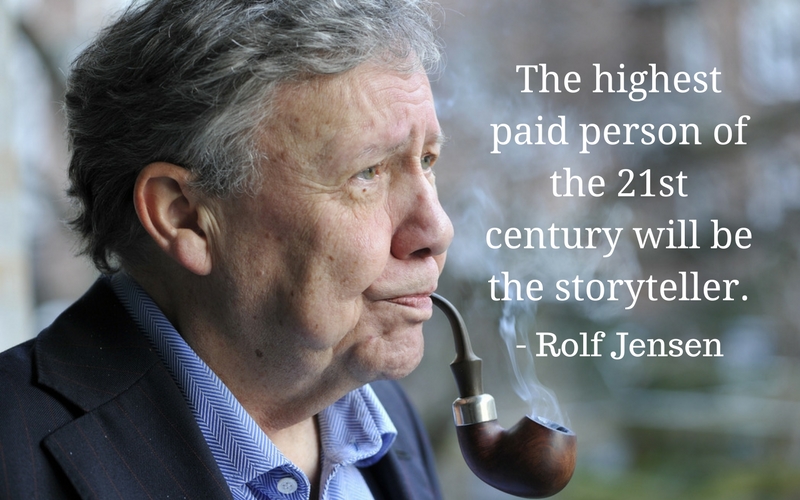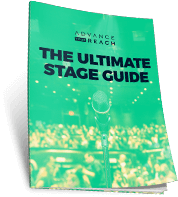The single most powerful tool to grow your business is storytelling. Ironically, in this world where technology offers us unlimited information, people are starved for true, authentic stories.
Your story is unique, and no matter who you are, you’ve got something in your story that can help people. Inside you, there is a story that is relatable, shows who you are, and speaks to universal emotions.
The greatest speakers always open with stories like this; they are vulnerable with who they are. They share. We call it “leading with the heart”.
Crafting your story into a signature talk
A signature talk is a presentation or speech that you can use at events, webinars, podcasts, and many other situations to present your mission and expertise. A signature talk has 4 main components.
- The heart – A personal and relatable story that gives a “why” behind what you do.
- The head – The main body of your presentation where you give actionable advice to solve the problem you’re discussing.
- The hands – A call to action encouraging your listeners to go out and face this problem.
- The heart – An emotional close that ties your talk together and resolves the experience you create.
The most crucial part of a signature talk is “leading with the heart”. If you can master the foundations of storytelling and build a great signature talk, you’ll create a powerful tool for your business.
[bctt tweet=”Master the #storytelling in your signature talk, and you’ll create a powerful tool for your business.” username=”advancereach”]
A good 30-minute story in front of the right audience can build more trust than weeks of online content, email marketing, social media, or any other high-tech tool on the market today. A story makes you memorable and will cause people to associate you with the problem you solve. Even if a person who hears your story will never become a customer, they may mention you to friends and colleagues that could use your help.
The power of a story goes far beyond the stage; a good story can transform your team culture. If your team members understand and resonate with the story behind your brand, they’ll be more meaningfully engaged with their work. This boosts the performance on your team and makes it harder for your star players to get snatched up by a better offer.
Let’s explore some strategies for creating a great story that can drive your business and energize your brand. Once we lay out a framework for how you can create a good story, we’ll examine some tactics you can use to have a big impact when speaking.
Isn’t Storytelling Only For Inspirational Speakers?
Storytelling seems like an obvious fit for motivational and inspirational speakers, but what about other businesses? Is storytelling useful for more “serious” business models like accounting, life insurance, or software development?
Absolutely.
No matter what niche you are in or who your audience is, stories can transform businesses. The desire and appreciation for a good story are hardwired into every human. Even if you have a business that is “boring”, your life, your business, and your team are all filled with powerful stories that you can use.
[bctt tweet=”No matter what niche you are in or who your audience is, stories can transform businesses. #Storytelling” username=”advancereach”]
How To Find Your Story
Often in crafting a story, the most difficult step is the first one. Figuring out what your story is. People write themselves off and don’t think their story would be interesting. Everyone has the raw materials for a great story; it’s just a matter of discovering them.
Here are a few questions you can ask yourself to dig up your story and give you a little inspiration.
Why do you do what you do?
You probably have some good reasons why you are in the business and industry that you’re in. There’s a reason why you started out on this challenging journey to solve a problem for people. Maybe it’s a passion for the product you are creating, maybe you feel deep empathy for the customers you work with, or maybe the problem you solve now is one you experienced yourself in the past.
Looking in on these basic reasons for why you do what you do can often reveal a story and some of your differentiators.
What are some of the core values of your business? Is there a story behind why those are important to you and now a core element of your business?
Where did you come from?
Your audience wants to know the history of your business and your own personal history if you are the face of your brand.
Were there any key points in your business where you needed to make a tough decision? Did it change how you operate fundamentally?
Are there any stories from your past clients that you can share that give a glimpse into your own history?
How have you failed?
Though sometimes difficult to share, failures are often excellent places to look for a story. They have some of the key elements of “The Hero’s Journey” built into them. People can relate to your more easily through stories of failure. They associate the pain they currently feel with your story and start to anxiously await learning how you succeed.
The Formula For A Great Story -The Hero’s journey
[bctt tweet=“The highest-paid person of the 21st century will be the storyteller.” – Rolf Jensen ” username=”advancereach”]
Something that holds many people back from storytelling is they simply don’t know how to tell a good story. It turns out most of our favorite stories follow a pattern. You can see this pattern play out in movies, books, and talks everywhere. The pattern is called “The Hero’s Journey.” This term was coined by Joseph Campbell after studying hundreds of ancient myths and stories.
Here’s a great video that illustrates “The Hero’s Journey” and compares it to some of the most popular stories of our time.
Here’s a breakdown of the different points of The Hero’s Journey. Remember that your story may not fit perfectly into this archetype. You may need to change the order of a few of these points or remove some that aren’t relevant to you.
- Status Quo – Everything’s normal. The beginning of your story.
- Call to adventure – There’s a desire or an invitation for something more, something better. This could also be a problem that is bothering you, and it forces you out of your comfort zone. This desire or problem should resonate with your audience and what they desire as well.
- Assistance – You receive some help or guidance to help set you on your path. This could be a mentor giving you guidance on what to do next. Mentioning others that seemed to have solved the problem you have or are at a place you aspire to get to.
- Departure – You’re off on your new adventure. You get some early wins and you think life is always going to be this easy.
- Trials – This is where your struggle begins. You hit some unexpected setbacks. You start to share some of the pain you’re experiencing.
- Approach – Things are getting harder, you’re losing momentum, experiencing doubts. You are experiencing the fears and pain that your audience wants to avoid.
- Crisis – Just when you thought it couldn’t get any worse… It did. You hit rock bottom. You experience painful emotions, and you start thinking about the long term consequences and ramifications of not solving this problem. You’re about to give up…
- Treasure – You find the thing that can turn it all around. Maybe it’s an idea, and maybe it’s a tool, a new way of looking at things, a new person you meet, or a process. This should relate closely to the solution you provide in your business.
- Result – You decide to take action, and you use this newfound treasure to solve the big problem you’re experiencing. You start to see new results coming. These are the results that your audience craves.
- Return and resolution – You’re getting new results with your new treasure, things are looking hopeful again. Best of all, the solution to the problem was something anyone could do or use. The results you get are within anyone’s reach.
Visualizing the Hero’s Journey
Another way to visualize the hero’s journey is through a graph. I prefer graphs to the circle shown in the video because many business owners and entrepreneurs work with graphs all the time and appreciate a good way to visualize information.
Here’s what Cinderella looks like a graph. I have added some notes to show how it aligns with The Hero’s Journey framework.
A graph is just one of many visual storytelling strategies. Using visuals can dramatically enhance the emotional impact and memorability of the story you share.
Vulnerability
“Vulnerability is the birthplace of love, belonging, joy, courage, empathy, and creativity. It is the source of hope, empathy, accountability, and authenticity. If we want greater clarity in our purpose or deeper and more meaningful spiritual lives, vulnerability is the path.”
― Brené Brown, Daring Greatly
A key to “leading with the heart” in your story is a vulnerability. Vulnerability is something many entrepreneurs avoid because they fear that exposing their flaws or weaknesses will diminish their credibility. But vulnerability and authenticity are foundational to a great talk. They are the tools you’ll need to build a connection with your audience.
Vulnerability is not easy, and it often takes a lot of practice and self-reflection be able to share your story fully.
Usually, the “crisis” point in your “hero’s journey” is where vulnerability is essential. The crisis point is one of the essential parts of a good story. It’s when people are sitting on the edge of their seats, wondering what will happen next. They share the pain you felt and empathize with you. Holding back, your vulnerability can deflate the power of your story.
Take Them Into the Room
A common mistake people make is they tell their stories from a third-person perspective. As if they were the Ghost of Christmas Past taking their audience to see their story from a distance. Observing from afar, but not directly engaging with the story. The problem with this approach is it reduces the emotional impact and relatability of your story.
Pat Quinn, master storyteller and host of the Amazing Presenter’s conference recommends that you “take them into the room with you”. What he means by that is to tell your story from the first person, take us into your own mind at that moment. Re-live the story and share that experience. Describe small visceral details to bring context to your story that brings out the emotions you were feeling without directly saying it.
Bad example: “I remember feeling heartbroken when I discovered we had to move out of our house. We could not afford it anymore. I saw the sad looks on my children’s faces, and knew I had hit a low point in my life.”
Good example: “I remember carrying out my children’s toys to the front of our house for a yard sale. I nearly cried when I asked them to choose which toys they wanted to keep. Confusion on their faces as I explained how we could not afford to live in our house anymore.”
Open Strong On Stage
Your first few seconds on the stage are crucial for the success of your talk.
If you mosey onto the stage and open with slow, unenthusiastic speech, your audience will check out, and it will be difficult to get them back.
Take the stage with energy; make it obvious how excited you are to be talking and sharing. Complement the audience, remind them how smart they are for being at this event. Give a hat tip to the people behind the event and show gratitude for inviting you to speak.
An easy trick to capture the audience’s attention right at the beginning is to open with a “few quick tips”. Tell them to grab their pens and get ready for some notes then fire off a few valuable ideas.
Another tactic engages the audience through questions. “Have you ever had problem X?” or “Does anyone want more Y in their lives?” Raise your hand up to invite the audience to do the same if they agree. If you can tap into an emotion or a desire for your audience right away and get them saying “yes” early, you’ll capture their attention and keep them focused during your talk.
Let’s look at a live example of how Grace Smith, owner of Grace Space, makes a strong opening by polling the audience about their stress and asks if they want a fast and easy solution to the stress they feel. She then gives them an interactive activity by asking them to examine their current stress and continues to keep them engaged.
Grace’s opening captured people’s attention immediately, got them feeling strong emotions, and made them excited to learn her solution. All in less than 60 seconds.
Bake Social Proof Into Your Business Storytelling
Many speakers will list off past achievements, clients, or successes like they are reading off their resumé. This approach often comes off as boring and braggadocious. But including social proof in your talk is critical for building trust and authority with your audience.
Bad example: “I charge $30,000 for my service and only work with high-quality businesses, and I’m often booked out months in advance.”
A good approach is to weave these facts into a story and train your audience to expect certain behavior from you.
Good example: “A few days ago, I got a call from a big potential client. I let them know I could not start work with them for another few months and the work would cost $30,000. They said, “We were thinking more like $20,000,” and they asked if I had a cancellation policy.
Now, I was willing to give them a bit of a discount if they paid it all upfront, but told them I didn’t have a cancellation policy, I only worked with people who were serious about this.
They respected this boundary and ended up taking my offer to pay up front.”
“Landing the Plane” – How to Close Your Story
A strong close is as important as a strong open in your story, but there are a few risks that come at the end of your presentation. The biggest is timing; if you go over time, have to cut off your talk or rush through it, you’ll damage the trust you have built up with your audience. You’ll lose that opportunity to leave a powerful impression that incites action in your audience.
Here are a few tips for a strong close:
Know exactly how long the close of your story will take – Keep a close eye on the time you have left and drop everything to transition into your story.
Build flex time into your presentation – A good option for flex time is opening the floor to Q & A before you close. You can answer as many questions as you have time for then transition into your closing story.
False finish slides – Create a few closing slides throughout your presentation. So you can have a few places you can end your presentation. This keeps you from looking disorganized and skipping forward to your closing slide if you’re short on time.
Take care of “housekeeping” before you close – Most speakers mention they have books for sale, a booth in the back, or how they can be contacted as an afterthought of their presentations. As soon as you close, people will begin talking with their neighbors, rushing to the bathroom, or heading for the coffee bar. Mention all of these things before your close while you have their attention.
Let’s look at an example of this in action. Here’s a clip of Pat Quinn wrapping up one of his talks. Watch how he finishes with the main content of his talk then does a quick plug for his event and then opens up for a few questions to fill out a little bit of extra time in his talk. He wants to end with a story to make maximum impact. He knows how long his closing story is going to take and uses questions to make sure his story ends his talk ends exactly when it’s supposed to.
Start With One Story
It’s possible to build a thriving business around just one good signature talk. I recommend starting out by focusing on just one story, even if you have more than one that you think would be a good tool for your business. A great signature talk can be repurposed and reworked for many different formats and different audiences.
A good signature talk is not an easy thing to create, and it takes a great deal of time and effort to practice, refine, and test. By focusing on just one story, you can be sure that your story is optimized for impact.
A good story takes work to hone and refine into something great. By choosing just one, you’ll be able to bring out the best in it and start seeing results faster.
Need more inspiration for your storytelling? Check out 26 Tips For Storytelling
[bctt tweet=”A good story takes work to hone and refine into a great talk. #storytelling” username=”advancereach”]
Have Short and Long Versions of Your Story
As your speaking career develops, you’re going to have lots of different opportunities to speak, but they won’t all be the same. Maybe you’ll have an hour to speak on a podcast or a keynote speech. Sometimes you’ll have just 5 minutes to make a lasting impression. You’ll also have lots of opportunities to tell a bite-size version of your story in a minute or less in a passing conversation.
A master storyteller has their story prepared and practiced for all of these situations, so it comes off naturally and clearly.
A story is only one part of great talk, and you’ll want to keep it in good proportion with your content and the educational part of your talk. We recommend that your opening story take about 20% of the total time you have to speak. Though the shorter amount of time you have, the more time you should give to your story. In most cases, it’s difficult to convey a lot of good information in a 10-minute talk, but you can still create a good experience and a lasting impression with your story.
Conclusion
Crafting a good story to tell around your business and your content marketing can have as much impact at making a new hire if done well. Remember that your business storytelling is more than a marketing tool. It can also impact how your team feels about the work they do and how it fulfills their own purpose.
Telling your story truly takes courage because the best stories require you to be vulnerable and share some of your failures. But through that courageous act, you’ll help countless others solve the same problems and challenges you’ve faced.
Let your story bring wealth to your business and those you’ve set out to help, and let us help you with your story. Follow the steps in our Signature Talk Outline to develop your Signature Talk in a more compelling and impacting way. Download now to get started!











